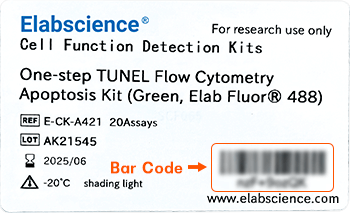Recombinant Mouse CLEC14A/EGFR-5 Protein (His Tag) (PKSM040750)

For research use only.
| Synonyms | 1200003C23Rik, AI642649 |
| Species | Mouse |
| Expression Host | HEK293 Cells |
| Sequence | Met 1-Thr 386 |
| Accession | NP_080085.3 |
| Calculated Molecular Weight | 40.6 kDa |
| Observed Molecular Weight | 75 kDa |
| Tag | C-His |
| Bio-activity | Not validated for activity |
| Form | Lyophilized powder |
| Purity | > 95 % as determined by reducing SDS-PAGE. |
| Endotoxin | < 1.0 EU per μg of the protein as determined by the LAL method. |
| Storage | Generally, lyophilized proteins are stable for up to 12 months when stored at -20 to -80℃. Reconstituted protein solution can be stored at 4-8℃ for 2-7 days. Aliquots of reconstituted samples are stable at < -20℃ for 3 months. |
| Shipping | This product is provided as lyophilized powder which is shipped with ice packs. |
| Formulation |
Lyophilized from sterile PBS, pH 7.4 Normally 5% - 8% trehalose, mannitol and 0.01% Tween 80 are added as protectants before lyophilization. Please refer to the specific buffer information in the printed manual. |
| Reconstitution | Please refer to the printed manual for detailed information. |
| Background | C-type lectin domain family 14 member A, also known as Epidermal growth factor receptor 5 and CLEC14A, is a member of the C-type lectin domain (CTLD) family that contains one c-type lectin domain and one EGF-like domain. Mouse CLEC14A is a 459 amino acid single-pass type I membrane protein. The superfamily of proteins containing C-type lectin-like domains (CTLDs) is a large group of extracellular Metazoan proteins with diverse functions. The CTLD structure has a characteristic double-loop ('loop-in-a-loop') stabilized by two highly conserved disulfide bridges located at the bases of the loops, as well as a set of conserved hydrophobic and polar interactions. Members of the C-type lectin/C-type lectin-like domain (CTL/CTLD) superfamily share a common fold and are involved in a variety of functions, such as generalized defense mechanisms against foreign agents, discrimination between healthy and pathogen-infected cells, and endocytosis and blood coagulation. Genome-level studies on human, elegans and melanogaster demonstrated almost complete divergence among invertebrate and mammalian families of CTLD-containing proteins (CTLDcps). The vertebrate CTLDcp families were essentially formed early in vertebrate evolution and are completely different from the invertebrate families. The composition of the CTLDcp superfamily in fish and mammals suggests that large scale duplication events played an important role in the evolution of vertebrates. |
Other Clones
{{antibodyDetailsPage.numTotal}} Results
-
{{item.title}}
Citations ({{item.publications_count}}) Manual MSDS
Cat.No.:{{item.cat}}
{{index}} {{goods_show_value}}
Other Formats
{{formatDetailsPage.numTotal}} Results
-
{{item.title}}
Citations ({{item.publications_count}}) Manual MSDS
Cat.No.:{{item.cat}}
{{index}} {{goods_show_value}}
-
IF:{{item.impact}}
Journal:{{item.journal}} ({{item.year}})
DOI:{{item.doi}}Reactivity:{{item.species}}
Sample Type:{{item.organization}}
-
Q{{(FAQpage.currentPage - 1)*pageSize+index+1}}:{{item.name}}




